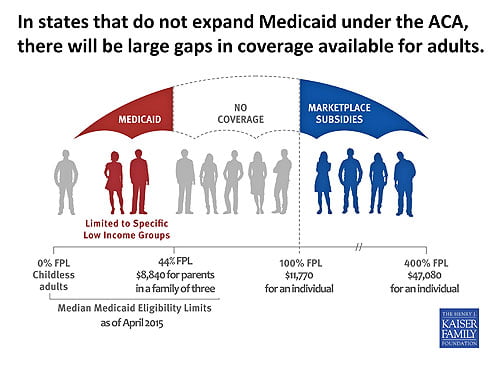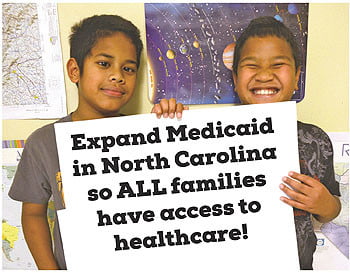Governor McCrory, “Where’s the Plan?”

Photo by Cathy DeWeese
Working people, parents, and children would receive significant help with health insurance coverage if North Carolina implements a plan to accept Federal Medicaid funding set aside for North Carolina.
On July 16th, doctors, patients, and advocates gathered at demonstrations across the state including here in Asheville to ask Governor McCrory, “Where’s the Plan?” to address the Medicaid coverage gap impacting over 500,000 North Carolinians.
At the Minnie Jones Health Center, in downtown Asheville, people gathered to voice their concerns, including Jerry Moncus, a 61-year-old man with Type 2 diabetes. He has been uninsured since he lost his job as a purchasing manager in 2009, during the recession. As a new business owner, he currently makes too little to qualify for subsidies through the insurance marketplace. If North Carolina had expanded the Medicaid program under the Affordable Care Act, he would have health coverage until his income grows.
Since the governor and General Assembly opted not to expand Medicaid, an estimated 8,400 Buncombe County residents will continue to go without health coverage in 2016. The governor previously stated that he would not release his proposal to expand Medicaid until the Supreme Court case, King v. Burwell, was resolved. That decision was handed down in June and the governor still has not released his plan. No other state has successfully closed the Medicaid gap without executive leadership.

“There have been too many delays and too many excuses,” said Asheville event organizer Peggy Weil of the Western North Carolina AIDS Project. “Having a chronic disease like heart disease, diabetes, or HIV, makes it nearly impossible to stay healthy and fully employed. Furthermore, preventive care reduces the need for costly emergency care.”
Speaker Kathey Avery, RN, of the Asheville Buncombe Institute of Parity Achievement (ABIPA), stated: “We have had screenings through ABIPA and found diabetes, hypertension and cardiovascular disease. Treatment can be delayed or limited, and finding doctors difficult. Medicaid can help our communities obtain annual physicals to detect and treat these individuals early so they don’t have worsened conditions, can live longer, healthier, and more productive lives.”

The Day of Action also included demonstrations in Charlotte, Greensboro, Raleigh, Greenville, and Fayetteville. The events featured people stuck in the Medicaid gap, along with healthcare providers, local elected officials, and healthcare advocates, including Joan Alker, Executive Director of Georgetown University’s Center for Children and Families. Speakers at all six events emphasized the importance of closing the coverage gap to avoid additional unnecessary deaths and to promote economic growth.
Alker, along with advocates at events across the state, also highlighted a study released this month by Georgetown University Health Policy Institute’s Center for Children and Families that illustrates the urgency of this issue for parents and children in North Carolina. The report shows that more than one-quarter of the people who would benefit from expanding coverage are parents with dependent children in the home.





